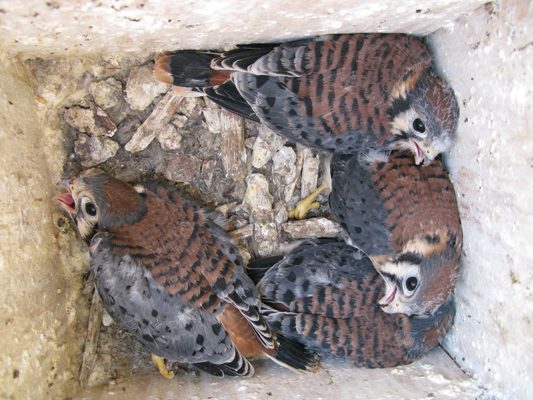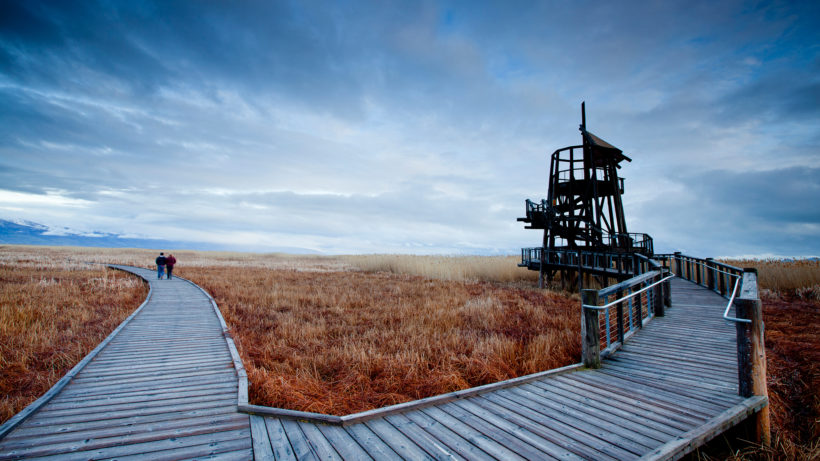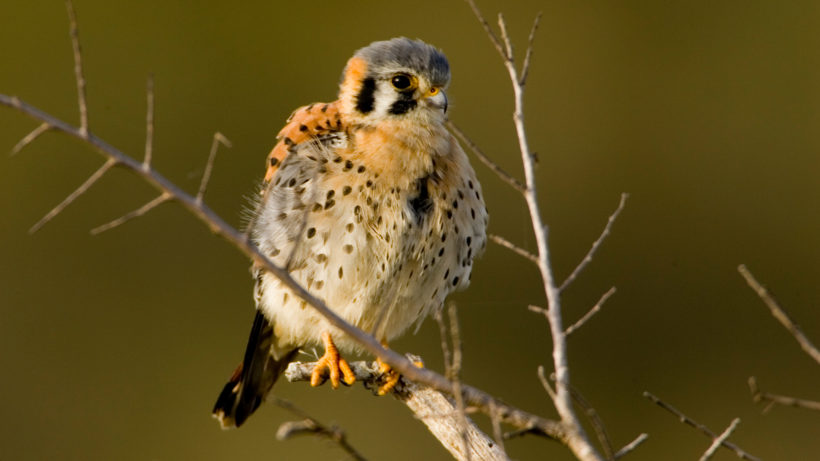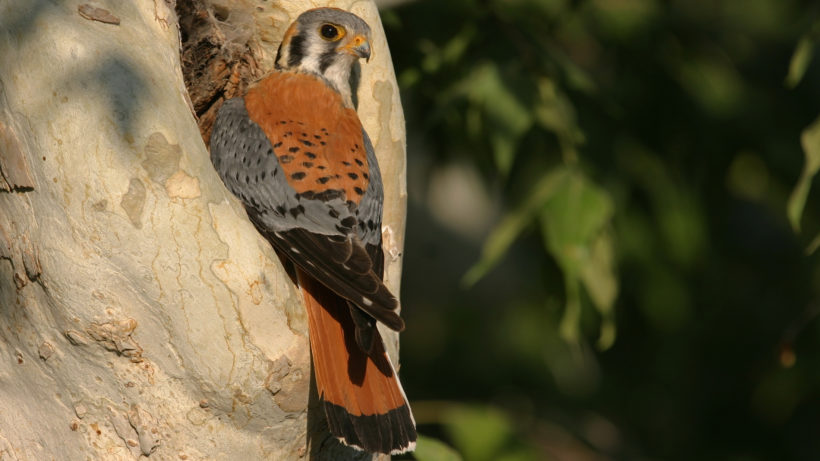I have a confession to make: I’ve never been that into birds—well, at least until recently.
When I was seven-years-old, I was on a field trip at the Great Salt Lake in Utah. I don’t remember much besides the insane number of bugs crashing into my skin, which was sticky with sweat and salt, and the feeling of bird droppings dripping down my forehead as an entire class of second graders pointed and laughed.
This place, these birds, were nightmarish things that I would continue to fear well into adulthood. So, when my coworker came to me a year ago with the idea to set up a kestrel nest cam at the Great Salt Lake, I’ll admit I was less than enthused.
But after all of the hard work to get the camera up and running, when the kestrels started visiting our nest box, something happened that I never expected. I became addicted to watching them, biting my nails anxiously to see if the male found his mate, and audibly cheering in my office when the nest footage revealed not one, but two eggs in the nest.
Bird cams, it turns out, are a lot of fun, and kestrels in particular are fiercely cute and fascinating.
Enthusiasm is Contagious
As my colleagues and I waited to see if the female kestrel would return to nest after laying her first egg, we discussed all the things we love about these birds. Some things we had never noticed before, like the face-like markings on the backs of their heads. Other things they had thought for a while, but their fond memories resurfaced as we watched this kestrel family grow. Their love of birds was starting to rub off on me.

Andrea Nelson, who had suggested we create a kestrel cam in the first place, particularly inspired me. “I look at birds of the Great Salt Lake as a tapestry,” she said. “We have more than 300 species of birds at the Great Salt Lake at different times of the year, migrating in and migrating out. The kestrels are just one little part of this beautiful tapestry.”
Not Your Average Wetland Bird
The truth is, when we think of Great Salt Lake birds, we often think of waterfowl, long-legged shore birds, birds that are feeding on brine shrimp and brine flies, and even birds that are feeding on the fish. But surrounding this huge and wonderful lake is all of this open land. Grasslands and wetlands stretch across this unique landscape, and it is here where upland birds find their habitat.
In these ecological niches, voles, mice, and rodents can be feasted upon by predatory birds. If left unchecked, too many rodents could decimate the native plant populations, which is why birds of prey are such a welcome sight at the Great Salt Lake Shorelands Preserve.
Standing from the boardwalk, you will see majestic hawks swoop down and catch their prey. And then, in the distance, a small American kestrel hovering above the grass, with the same great ferocity, will also make its kill. This is the delightful dance of species that make up the mosaic of the Great Salt Lake ecosystem.
“These cute, little, charismatic miniature falcons are killing machines,” Andrea laughs, “with super sharp talons and cool hooked beaks that are important to the greater ecosystem. They are filling this particular niche and keeping the rodent population under control.”

Common, But Not Unthreatened
It’s easy to laugh when you see kestrels and realize they’re such a powerful little package, but the reality is, these birds still need our protection.
Although kestrels are widespread across North America, they are losing their habitat to development like so many other birds at the Great Salt Lake. This area is a critical stopover in the West for migratory birds, which need lots of space to nest and feed during their visits. However, the cities nearby are expanding rapidly as the population in Utah booms, pushing new homes closer and closer to these important wetlands.
“I see these birds as ambassadors of this area,” Andrea continues. “They are a reminder that these birds are our neighbors, and we need to take care of them.”

As I sit and watch the kestrel nest, my nose inches from my computer screen, I’m letting go of my old fears. I learn something new about these birds every day, and I can’t help but care about what happens to them.
Like a worried parent, I grow anxious when the kestrels disappear from the nest for too long. But when the mama kestrel returns to her eggs once more, I let out a great sigh of relief. Maybe these kestrels will be okay after all. Maybe if people see what I see, they’ll want to protect them too, so we can be fortunate enough to observe them again next year, and the year after that.
I may be a budding birder yet.
UPDATE: Tune in to the 2023 nest cam in May and June!
This nestbox is one of 25 on TNC lands along the Great Salt Lake Shoreline. We partner with HawkWatch International, whose army of citizen scientists monitor these boxes along with 400+ others in Northern Utah each spring, and have done so since 2013 as part of an American Kestrel Partnership project.





The smaller of the two chicks left is flapping & climbing to the entrance. Maybe it is stronger than it seems and I hope it will do just fine.
I’ve been watching for weeks and share the concern about the smallest, weakest bird in the nest. It has not been fed much, if at all in days and seems too weak to make a sound or climb the wire up to the opening. The other remaining kestrel is calling and maybe will attract attention so that the parent will check on the last chick left in the box. However, that little guy seems doomed. My husband says the weakest are intended to be culled, so that only the strongest best hunters survive to breed. But in this instance, human interference has already occurred, so if it is abandoned, would a bird rescuer might take it to hand raise? Even if the bird cannot be released, it could have a live serving an education purpose as a “bird ambassador”
I think I’m too weak for this…I’m going to have to stop watching.
Hi Jeanne, Thank you for your question! We were not sure what would happen with this chick. The mother did feed it – though less often than the larger siblings. This is common for birds, to ensure that at least some of the chicks survive, the parents favor larger stronger chicks at feeding time. When food is plentiful, all of the chicks get enough to survive, but when food is scarce, some chicks don’t make it. It looks like this was a year of plentiful food and the chick has fledged. As of June 6, 2018, all five kestrels have left the nest. They are now off spreading their wings and hunting at the Great Salt Lake. Thank you for joining us during the debut season of our kestrel cam. We hope you’ll join us again next year!
I have many reservations about whether the voyeuristic nature of this endeavor is in the best interests of the birds. The tagging also leads me to conclude that these birds are not wild but born and raised in captivity.
The birds appear to know they are under the microscope here. That “awareness” raises many ethical concerns and while I did enjoy seeing this spectacle for the past few weeks I don’t think it’s something that we should be doing.
Privacy and ethical concerns over the surveillance state should at the very least be extended to animals.
This Truman Show for birds and animals should not be repeated.
Hi,
Do they eat on their own now? I haven’t seen anyone drop off any mice lately.
Hi Teresa, Thank you for your question! With the larger chicks out of the nest and hunting for themselves, the feedings got less frequent. The remaining chicks were being fed often enough to grow and fledge successfully. As of June 6, 2018, all five kestrels have left the nest. They are now off spreading their wings and hunting at the Great Salt Lake. Thank you for joining us during the debut season of our kestrel cam. We hope you’ll join us again next year!
Thank you, Lisa for tending to this site. I’m so happy all the chicks made it. It was a roller coaster for me, I couldn’t look away!
How old are the birds Now? 6/1/18 When will they start to leave?
Hi Maryann, The eggs were laid April 3 – 10 and the chicks hatched May 7. They are already starting to fly – we may have a few more days of watching before they all take off. Thank you!
I can’t tell because it’s so dark. Are there still five chicks?
There are! They do blend in more with the background now that they’re getting their adult plumage. Thank you!
Hi I think the camera was knocked out of place during the banding which is a real shame because now it’s nearly impossible to see what’s going on in the nest. If it’s possible for someone to fix that it would be awesome. Been watching these little guys since they were just eggs and I’d really love to be able to see them clearly again.
Hi Cait, The camera is in place. Depending on the time of day, especially now that the chicks’ feathers are getting darker, it can be tough to see them. Thank you for your interest!
May 29- where did they go? They were there at 7:30 am EST but gone at noon EST.
Hi Stacy, The kestrels are being banded today by HawkWatch International. You can see the video on The Nature Conservancy in Utah’s Facebook page: https://www.facebook.com/natureconservancyutah/ Thank you for the question!
Even though kestrels, like most species, are losing their natural habitat to humans, they seem to be pretty adaptable . They’re very common where I live and I saw one recently take a songbird not 15 feet from where I stood. They don’t seem very shy as long as there’s food around.